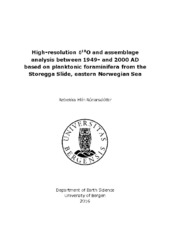High-resolution δ^18 O and assemblage analysis between 1949- and 2000 AD based on planktonic foraminifera from the Storegga Slide, eastern Norwegian Sea
Master thesis
Permanent lenke
https://hdl.handle.net/1956/13149Utgivelsesdato
2016-09-28Metadata
Vis full innførselSamlinger
- Department of Earth Science [1034]
Sammendrag
In this study are presented results from a high-resolution δ^18 O and assemblage analysis between 1949- and 2000 AD based on planktonic foraminifera from core GS13-182-01. The core was retrieved from the head of the Storegga Slide, eastern Norwegian Sea. From the core top down to 52.2 cm, 90 samples were analyzed, comprising the last 50 years. This level of resolution is unprecedented in the area, with 1-2 samples representing each year. Additionally, 30 samples between 8000- and 400 cal. yr. BP were analyzed. The high-resolution aids in interpreting multi-decadal and higher frequency climate variability such as the North Atlantic Oscillation (NAO) with evidence of annual temperature changes. Based on the known ecological preference of certain species of planktonic foraminifera, changes in their abundance were used to interpret changes in the dominance of local water masses. The results of the assemblage analysis were comparable to previous planktonic foraminifera studies in the area. Atlantic Water and Norwegian Coastal Water are the most influential in the area with clear indications of NAO influence. Instrumental temperature data from Ocean Weather Station Mike (OWSM) and Trondheim (TRON) was compared to the stable oxygen isotope results from both core GS13-182-01 and P1-003. The results confirm the conclusions of previous studies, predominately Sejrup et al. (2011, 2010) where the local near-surface signal is attributed to a basin wide North Atlantic signal rather than the climate of Scandinavia.
